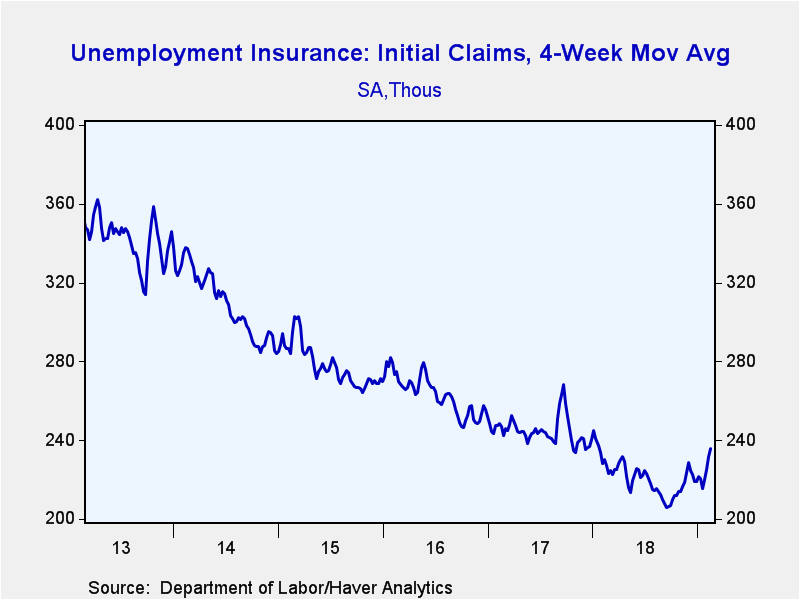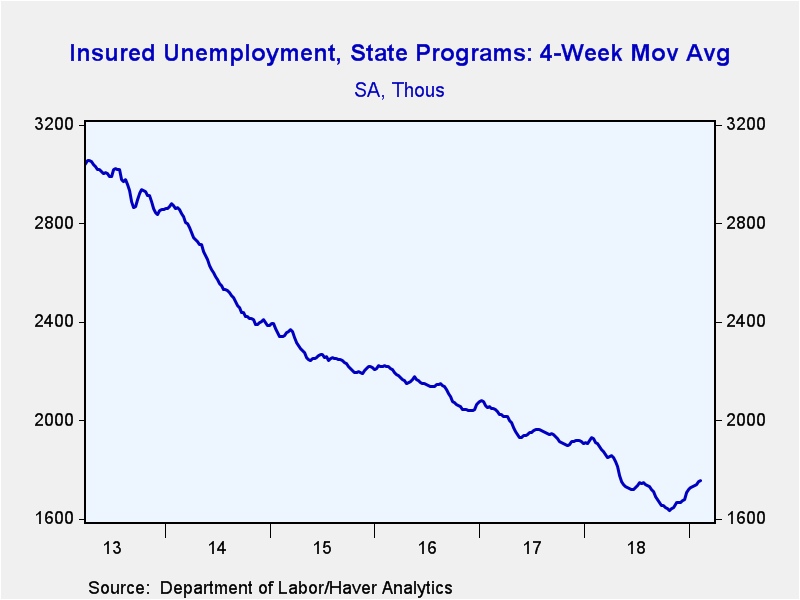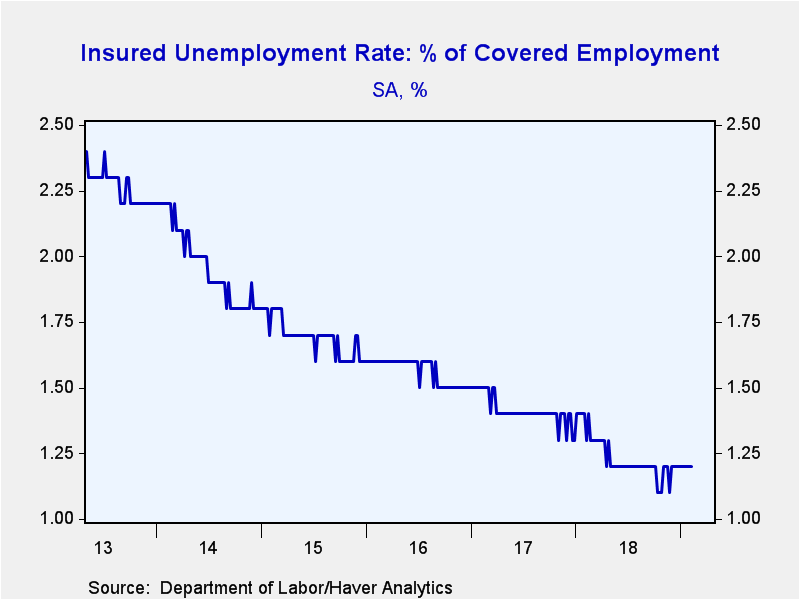 Global| Feb 21 2019
Global| Feb 21 2019U.S. Initial Claims for Unemployment Insurance Decline
Summary
Initial claims for unemployment insurance fell to 216,000 in the week ended February 16, down 23,000 from the previous week's 239,000; that figure was unrevised. The Action Economics Forecast Survey expected 225,000 claims this week. [...]
Initial claims for unemployment insurance fell to 216,000 in the week ended February 16, down 23,000 from the previous week's 239,000; that figure was unrevised. The Action Economics Forecast Survey expected 225,000 claims this week. The four-week moving average of initial claims was still rising, however, reaching 235,750, the largest amount since January 13, 2018.
Continuing claims for unemployment insurance also fell, dropping back to 1.725 million in the week ended February 9 from 1.780 million the previous week. The earlier number was revised up by 7,000. The four-week moving average of continuing claims increased to 1.755 million from 1.752 million in the prior week; the latest value is the highest since last May 5.
The insured unemployment rate - that is, continuing claims as a percent of covered employment - held steady at 1.2% in the February 9 week.
As we have noted here recently, federal government workers are covered separately from the regular state-administered programs. In the latest week available for the federal programs, February 9, initial claims were 919, down from 1,116 the prior week. These claims are thus returning to a more normal amount, absent the pressures from the government shutdown. The largest number of these initial claims during the shutdown was 25,419 in the January 12 week.
Insured unemployment rates in the state programs vary widely by state. These state data are not seasonally adjusted. During the week ending February 2, the lowest rates were in Florida (0.45%), North Carolina (0.51%), Tennessee (0.62%), Georgia (0.63%) and Virginia (0.65%). The highest rates were in Alaska (3.37%), New Jersey (2.80%), Rhode Island (2.58%), Montana (2.56%) and Pennsylvania (2.55%). Rates in other large-population states include California (2.19%), Texas (0.96%), New York (1.79%) and Illinois (2.30%).
Data on weekly unemployment claims going back to 1967 are contained in Haver's WEEKLY database and are summarized monthly in USECON. Data for individual states are in REGIONW. The expectations figure is from the Action Economics Forecast Survey, carried in the AS1REPNA database.
| Unemployment Insurance (SA, 000s) | 02/16/19 | 02/09/19 | 02/02/19 | Y/Y % | 2018 | 2017 | 2016 |
|---|---|---|---|---|---|---|---|
| Initial Claims | 216 | 239 | 235 | -0.9 | 221 | 244 | 262 |
| Continuing Claims | -- | 1,725 | 1,780 | -7.4 | 1,766 | 1,967 | 2,135 |
| Insured Unemployment Rate (%) | -- | 1.2 | 1.2 |
1.3 |
1.2 | 1.4 | 1.6 |
Carol Stone, CBE
AuthorMore in Author Profile »Carol Stone, CBE came to Haver Analytics in 2003 following more than 35 years as a financial market economist at major Wall Street financial institutions, most especially Merrill Lynch and Nomura Securities. She has broad experience in analysis and forecasting of flow-of-funds accounts, the federal budget and Federal Reserve operations. At Nomura Securites, among other duties, she developed various indicator forecasting tools and edited a daily global publication produced in London and New York for readers in Tokyo. At Haver Analytics, Carol is a member of the Research Department, aiding database managers with research and documentation efforts, as well as posting commentary on select economic reports. In addition, she conducts Ways-of-the-World, a blog on economic issues for an Episcopal-Church-affiliated website, The Geranium Farm. During her career, Carol served as an officer of the Money Marketeers and the Downtown Economists Club. She has a PhD from NYU's Stern School of Business. She lives in Brooklyn, New York, and has a weekend home on Long Island.









